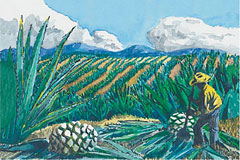This article first appeared in the Aspen Times on July 10, 2003.
Move over, honey, Sabra Van Dolsen is sweet on miel de agave.
Everyone else will be, too, if she has anything to say about it. And make no mistake – Van Dolsen has plenty to say about it. After all, introducing the “honey of the agave” to the United States has been an eight-year passion for a woman who is nothing if not tenacious when it comes to her product.
“I’ve been called obsessive,” the Aspenite admits.
Her obsession with the natural sweetener derived from the agave cactus is starting to pay off.
Coloradans will find the product on store shelves, packaged under the name Madhava Agave Nectar, at places like City Market, King Soopers, Whole Foods, Clark’s Market and Wild Oats. Safeway has just recently agreed to add it to its natural-foods section nationwide.
In Aspen, coffeeshops offer bottles of the nectar right next to the little packets of sugar and artificial sweeteners that coffee and tea drinkers reach for regularly. Local chefs are adding it to their dishes, relishing its unique properties – it’s sweeter than refined sugar, but more delicate in flavor than honey.
They’ve discovered what Van Dolsen has known since she stumbled across miel de agave in 1995: “It’s just a really wonderful sweetener.”
Less viscous than honey, agave nectar dissolves easily in hot and cold beverages. And, it doesn’t crystallize, like honey does, giving it a longer shelf life.
The organic sweetener, which comes in light, amber and dark grades, has a place in some high-profile Aspen kitchens, including Chef Charles Dale’s new restaurant, Range, and the Willow Creek Bistro at the Ritz-Carlton Club.
“I think honey is a very distinct flavor, whereas the agave is a little more neutral flavor,” said Matthew Zubrod, executive chef at Willow Creek. “You can tell pretty easily when honey is in something. I don’t think you can as easily with agave.”
Agave nectar plays an important role in Zubrod’s duck dish, both in the marinade and in the agave-lavender vinaigrette he serves with it. The bistro’s breakfast diners probably don’t know it, but they’re enjoying agave nectar in the dipping sauce for Zubrod’s banana bread. He combines the nectar with lemon yogurt for the sauce.
At Blue Maize, agave nectar is the only honey-style ingredient chef Thomas Colosi uses. It has found its way into a half-dozen or so of his Southwestern dishes since Charles Dale introduced him to the sweetener.
“It’s just got a lot smoother flavor,” Colosi said. “It’s a nice, smooth way of introducing the chiles I use into a dish.”
It was a chance encounter with a manufacturer’s representative who was trying to introduce agave syrup to the United States that gave Van Dolsen her first taste of the sweetener.
“I realized the product was very compelling,” she said. “I gave samples to all of my friends in Aspen. They all loved it.”
Van Dolsen, who used to add sugar to her coffee and tea, switched exclusively to the nectar.
“I thought, if I converted to agave nectar, that would mean millions of other people would do it as well,” she reasoned.
Her original contact with the Mexican businessman has long vanished, but Van Dolsen’s own commitment to get the nectar into commercial production and bring it to the market remains. It hasn’t been easy.
“It has been quite a convoluted, roller-coaster ride. Eight years is a long time,” she said. “If I have something to congratulate myself for, it’s tenacity.”
Mexico is a challenging country in which to do business, especially for a woman, Van Dolsen concedes. She was born there though, to American parents, and resided in Mexico as a toddler, giving her a special affinity for the country.
“I really wanted to become involved in a project that contributed to the socioeconomic development of Mexico,” she explained. “I really do believe this product does exactly that.”
Van Dolsen, who spent part of her childhood and early adult years in Aspen before moving back in 1995, teamed up with longtime Aspen friend Jeanette Kappeli to start the agave venture. They founded The Colibree Co. with the intention of getting agave nectar into production.
Kappeli’s mom donated $5,000 to the effort. So did three of Van Dolsen’s college chums. Later, a private offering netted additional capital from other investors/agave believers.
The initial investments funded a pilot production effort at the University of Guadalajara in Mexico. Then, on the verge of a deal with a large food conglomerate, the price of blue agave skyrocketed from $80 per metric ton to $1,400 a ton in 1999. The plan fell apart.
“By that time, my investors were like, `Sabra, just give it up . it’s a tax loss, don’t worry about it,’ ” she recalled.
A shortage of blue agave, in combination with a growing U.S. thirst for tequila, derived from the juice of the cactus, resulted in the huge jump in price for blue agave and ruled it out as a source of the sweetener.
Van Dolsen didn’t give up. In the fall of 2000, she returned to Mexico and found partners who could pull off the production end of things.
The Colibree Co. joined forces with Nekutli (it means “the sacred juice of the agave” in an Aztec dialect), an agricultural collective paired with a manufacturing entity. More than 60,000 Mexican farmers provide the raw material from alternate species of agave; production of the nectar began a year ago.
The Colibree Co. buys the nectar in bulk from Nekutli and then sells it to U.S. honey companies that package and distribute it. In Colorado, Lyons-based Madhava bottles the product under its label.
Now, Van Dolsen is seeking partners that can help Colibree package and distribute the nectar nationwide under the company’s own label.
Only when American consumers and food manufacturers are buying Colibree-brand agave nectar will Van Dolsen know the sweet taste of success.





